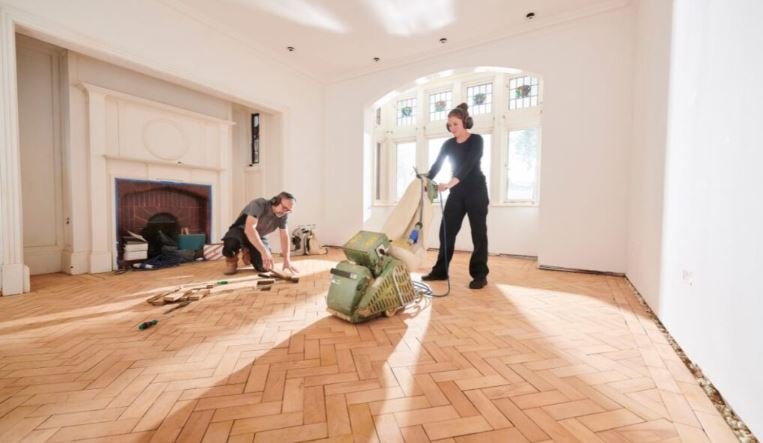In the quest to create a safe and comfortable living environment, the choice of flooring plays a crucial role, influencing not just the aesthetics but also the safety of a home. Among the many factors to consider, slip resistance and fire protection stand out as critical aspects that can have a significant impact on household safety. This comprehensive guide delves into these essential considerations, providing insights into how to choose flooring that not only enhances the beauty of your space but also ensures your family’s well-being.
Understanding the Importance of Flooring Safety
Flooring is a foundational element in home design, impacting both functionality and safety. Slip resistance and fire protection are two critical aspects that must be carefully evaluated to prevent accidents and hazards.
1. Slip Resistance: The Key to Preventing Falls
Slip resistance is a fundamental aspect of flooring safety, particularly in areas prone to moisture, such as kitchens, bathrooms, and entryways. Slips and falls are common accidents that can lead to serious injuries, especially among young children and the elderly. Ensuring that your flooring has adequate slip resistance is essential for minimizing these risks.
2. Fire Protection: Safeguarding Your Home
Fire safety is another vital consideration when selecting flooring materials. Different flooring types have varying levels of fire resistance, which can affect how quickly a fire spreads and how easily it can be controlled. Choosing flooring with better fire-resistant properties can significantly enhance the safety of your home during an emergency.
Slip Resistance: Factors to Consider
Slip resistance is determined by a combination of factors, including the texture of the flooring material, its surface finish, and the environment in which it is used. Here’s a detailed look at how to evaluate and enhance slip resistance in your home:
1. Flooring Material and Texture
- Ceramic and Porcelain Tiles: These materials are often a popular choice for areas where slip resistance is crucial. Tiles with a textured surface or slip-resistant finish can provide better grip, reducing the risk of slipping.
- Vinyl Flooring: Vinyl is another excellent option, especially when it comes with a slip-resistant surface. Modern vinyl flooring can be designed with embossed textures to enhance grip.
- Wood Flooring: Traditional wood floors can be prone to slipping, especially when polished. Opting for finishes that add texture or using anti-slip rugs and mats can help mitigate this issue.
2. Surface Finish
- Polished vs. Matte: Polished floors, while aesthetically pleasing, can be slippery, especially when wet. Matte or textured finishes are generally better at providing traction.
- Sealants and Coatings: Applying slip-resistant sealants or coatings to your flooring can improve its grip. These products are available for various types of flooring, including tile, wood, and vinyl.
3. Environmental Considerations
- Wet Areas: In areas like bathrooms and kitchens, where spills are common, choosing flooring with high slip resistance is essential. Consider materials specifically designed for wet environments, such as slip-resistant vinyl or textured tiles.
- High Traffic Areas: For high-traffic areas, durability combined with slip resistance is crucial. Commercial-grade vinyl or textured laminate flooring can offer both durability and safety.
4. Testing and Standards
- Slip Resistance Ratings: Familiarize yourself with slip resistance ratings, such as the Coefficient of Friction (COF) or the Dynamic Coefficient of Friction (DCOF). These ratings can help you choose flooring that meets safety standards.
- Testing Methods: Conduct slip resistance tests to ensure that the flooring you select performs well under typical conditions. Many flooring manufacturers provide test results for their products.
Fire Protection: Essential Considerations
Fire safety in flooring is an often-overlooked aspect of home design, but it is crucial for protecting your home and family. Here’s what you need to know about ensuring fire protection through your flooring choices:
1. Fire-Resistant Materials
- Concrete and Stone: Concrete and natural stone flooring are inherently fire-resistant materials. They do not burn or emit toxic fumes, making them ideal for areas where fire safety is a concern.
- Ceramic and Porcelain Tiles: These tiles are also fire-resistant and do not contribute to the spread of flames. They are suitable for use in both residential and commercial settings.
- Fire-Resistant Vinyl: Modern vinyl flooring options are often designed with fire-resistant properties. Check for certifications that indicate compliance with fire safety standards.
2. Fire Ratings and Standards
- Fire Ratings: Flooring materials are often rated based on their fire resistance. Look for ratings such as the Flame Spread Index or the Smoke Developed Index to determine how well the flooring material performs in a fire.
- Building Codes: Ensure that your flooring choices comply with local building codes and fire safety regulations. These codes provide guidelines for materials that meet safety standards.
3. Installation and Maintenance
- Proper Installation: Ensure that flooring is installed correctly to prevent gaps or seams that could affect fire resistance. Professional installation can help meet safety standards and ensure optimal performance.
- Regular Maintenance: Maintain your flooring by following manufacturer guidelines. Regular cleaning and prompt repair of any damage can help preserve its fire-resistant properties.
4. Complementary Measures
- Fire Alarms and Sprinklers: While flooring is an important aspect of fire safety, it should be part of a comprehensive fire protection plan. Install smoke alarms, fire extinguishers, and sprinkler systems to enhance overall safety.
- Escape Routes: Ensure that flooring materials in exit routes are both slip-resistant and fire-resistant. Clear, well-marked escape routes can be crucial during an emergency.
Choosing the Right Flooring for Your Needs
When selecting flooring, balance slip resistance and fire protection with other factors such as aesthetics, durability, and cost. Here are some tips for making an informed decision:
1. Assess Your Needs
- Functionality: Consider the specific needs of each room in your home. High-traffic areas, wet environments, and fire-prone zones may require specialized flooring.
- Lifestyle: Your lifestyle and household activities can influence your flooring choices. For example, families with young children or elderly members might prioritize slip-resistant flooring.
2. Research and Compare
- Product Reviews: Research flooring options and read reviews to understand their performance in real-world conditions. Look for feedback on slip resistance and fire safety.
- Consult Professionals: Seek advice from flooring experts or contractors who can provide insights into the best options for your specific needs.
3. Test Samples
- Request Samples: Obtain samples of flooring materials to test their slip resistance and fire properties in your home environment. This can help you make a more informed decision.
- Test in Different Conditions: Evaluate how the flooring performs under different conditions, such as wet or high-traffic situations, to ensure it meets your safety requirements.
Ensuring safety through proper flooring choices is an integral part of home design. By carefully considering slip resistance and fire protection, you can create a safer living environment that minimizes risks and enhances overall comfort. Whether you’re renovating an existing space or designing a new home, prioritize these safety aspects alongside aesthetic and functional considerations. With the right approach, you can achieve a beautiful, secure, and practical flooring solution that meets the needs of your household and ensures peace of mind.





